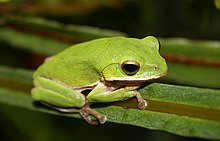Zhangixalus
| Zhangixalus | |
|---|---|

| |
| Zhangixalus arvalis from Taiwan | |
| Scientific classification | |
| Domain: | Eukaryota |
| Kingdom: | Animalia |
| Phylum: | Chordata |
| Class: | Amphibia |
| Order: | Anura |
| Family: | Rhacophoridae |
| Subfamily: | Rhacophorinae |
| Genus: | Zhangixalus Li, Jiang, Ren, and Jiang, 2019[1] |
| Type species | |
| Polypedates dugritei David, 1872
| |
| Species | |
|
40 species (see text) | |
Zhangixalus is a group of frogs in the subfamily Rhacophorinae, family Rhacophoridae.[2][3] They are called Zhang's treefrogs in English.[1][2] They live in the Eastern Himalayas, southern China, Taiwan, Japan, and southeast Asia.[2]
Name
[change | change source]The frogs are named for Zhang Ya-Ping from the Chinese Academy of Sciences. Zhang worked in biodiversity and evolution research in China. Ixalus is a word that means treefrogs.[1]
Taxonomy
[change | change source]Scientists made the group Zhangixalus in a 2019 when they were looking at the very large genus Rhacophorus (92 species). They divided Rhacophorus into three groups: Rhacophorus sensu stricto (then 39 species; as of November 2021, 43 species[4]), Leptomantis (then 14 species; as of November 2021, 13 species[4]), and Zhangixalus (then 37 species; as of November 2021, 40 species[4]). They did this because of molecular data, such as DNA, but also because they could see differences in the frogs' bodies and in the places where they lived. Rhacophorus is the sister taxon of Zhangixalus and Leptomantis.[1]
Description
[change | change source]Zhangixalus are large frogs, ranging between 30 and 120 mm (1.2 and 4.7 in) in from nose to rear end, but most are more than more than 50 mm (2.0 in). The snout is round. The terminal phalanges of fingers and toes are Y-shaped. Dorsal skin is smooth or has some small bumps. Most frogs have green skins. The female lays eggs in white foam nests that the two frogs make together.[1]
Zhangixalus has frogs that seem not to be related to other frogs: Z. achantharrhena, Z. dulitensis, and Z. prominanus. They are different from other Zhangixalus frogs: they have folds in their skin by their legs and tarsal projections. Scientists are not sure these species really should be in Zhangixalus.[1]

Species
[change | change source]There are 41 species in this genus:[2]
- Zhangixalus achantharrhena (Harvey, Pemberton, and Smith, 2002)
- Zhangixalus amamiensis (Inger, 1947)
- Zhangixalus arboreus (Okada and Kawano, 1924)
- Zhangixalus arvalis (Lue, Lai, and Chen, 1995)
- Zhangixalus aurantiventris (Lue, Lai, and Chen, 1994)
- Zhangixalus burmanus (Andersson, 1939)
- Zhangixalus chenfui (Liu, 1945)
- Zhangixalus dennysi (Blanford, 1881)
- Zhangixalus dorsoviridis (Bourret, 1937)
- Zhangixalus duboisi (Ohler, Marquis, Swan, and Grosjean, 2000)
- Zhangixalus dugritei (David, 1872)
- Zhangixalus dulitensis (Boulenger, 1892)
- Zhangixalus feae (Boulenger, 1893)
- Zhangixalus franki Ninh, Nguyen, Orlov, Nguyen, and Ziegler, 2020
- Zhangixalus hongchibaensis (Li, Liu, Chen, Wu, Murphy, Zhao, Wang, and Zhang, 2012)
- Zhangixalus hui (Liu, 1945)
- Zhangixalus hungfuensis (Liu and Hu, 1961)
- Zhangixalus jarujini (Matsui and Panha, 2006)
- Zhangixalus jodiae Nguyen, Ninh, Orlov, Nguyen, and Ziegler, 2020
- Zhangixalus leucofasciatus (Liu and Hu, 1962)
- Zhangixalus lishuiensis (Liu, Wang, and Jiang, 2017)
- Zhangixalus melanoleucus Brakels, Nguyen, Pawangkhanant, Idiiatullina, Lorphengsy, Suwannapoom & Poyarkov, 2023
- Zhangixalus minimus (Rao, Wilkinson, and Liu, 2006)
- Zhangixalus moltrechti (Boulenger, 1908)
- Zhangixalus nigropunctatus (Liu, Hu, and Yang, 1962)
- Zhangixalus omeimontis (Stejneger, 1924)
- Zhangixalus owstoni (Stejneger, 1907)
- Zhangixalus pachyproctus Yu, Hui, Hou, Wu, Rao, and Yang, 2019
- Zhangixalus pinglongensis (Mo, Chen, Liao, and Zhou, 2016)
- Zhangixalus prasinatus (Mou, Risch, and Lue, 1983)
- Zhangixalus prominanus (Smith, 1924)
- Zhangixalus puerensis (He, 1999)
- Zhangixalus schlegelii (Günther, 1858)
- Zhangixalus smaragdinus (Blyth, 1852)
- Zhangixalus suffry (Bordoloi, Bortamuli, and Ohler, 2007)
- Zhangixalus taipeianus (Liang and Wang, 1978)
- Zhangixalus viridis (Hallowell, 1861)
- Zhangixalus wui (Li, Liu, Chen, Wu, Murphy, Zhao, Wang, and Zhang, 2012)
- Zhangixalus yaoshanensis (Liu and Hu, 1962)
- Zhangixalus yinggelingensis (Chou, Lau, and Chan, 2007)
- Zhangixalus zhoukaiyae (Pan, Zhang, and Zhang, 2017)
The AmphibiaWeb recognizes the same species except Zhangixalus amamiensis, which is treated as being part of Zhangixalus viridis.[3]
References
[change | change source]- ↑ 1.0 1.1 1.2 1.3 1.4 1.5 Jiang, Dechun; Jiang, Ke; Ren, Jinlong; Wu, Jun & Li, Jiatang (2019). "Resurrection of the genus Leptomantis, with description of a new genus to the family Rhacophoridae (Amphibia: Anura)". Asian Herpetological Research. 10 (1): 1–12. doi:10.16373/j.cnki.ahr.180058.
- ↑ 2.0 2.1 2.2 2.3 2.4 Frost, Darrel R. (2021). "Zhangixalus Li, Jiang, Ren, and Jiang, 2019". Amphibian Species of the World: an Online Reference. Version 6.1. American Museum of Natural History. doi:10.5531/db.vz.0001. Retrieved 16 November 2021.
- ↑ 3.0 3.1 "Rhacophoridae". AmphibiaWeb. University of California, Berkeley. 2021. Retrieved 16 November 2021.
- ↑ 4.0 4.1 4.2 Frost, Darrel R. (2021). "Rhacophorinae Hoffman, 1932 (1858)". Amphibian Species of the World: an Online Reference. Version 6.1. American Museum of Natural History. doi:10.5531/db.vz.0001. Retrieved 16 November 2021.